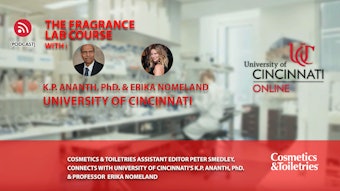Editor’s note: This is the second of a three-part series on skin protectants. Here, theoretical aspects of skin protection are described, and insights in the area of perfluoropolyethers are introduced. Part three will explore a solution based on the concept of shielding skin; part one discussed practical challenges to skin protection efficacy.
A paper on barrier creams presented by Parish in 1987 at a cosmetic dermatology meeting concluded, “The ideal barrier cream has yet to be designed. The problem of water solubility and alcohol solubility make a universal cream next to impossible.”1 At that time, these chemical challenges were not perfectly expressed—i.e., referring to alcohol rather than oil solubility—but they stated a real issue: the difficulty of separating the performance of the finished product from that of its pure ingredients. More optimistic than Parish, and some 17 years later, a review by Maibach2 on skin protectants concluded, “The ideal anti-irritant may in fact exist.” However, the answer has not become any clearer in recent years, according to other reviews by Maibach on anti-irritants and their potential clinical use, as deduced from human, animal and in vitro studies.3, 4
In these reviews, skin protectants, often referred to as anti-irritants, are defined as substances that “either inhibit (prevent) and/or treat contact dermatitis.” This definition for what constitutes an anti-irritant is wide-ranging because various types of dermatitis—and consequently, the related functions of the anti-irritants—are considered. Examples of dermatitis include immediate vesiculation and blistering caused by sulfur mustard and other chemical weapons; inflammatory effects due to dermatological treatments with retinoids or glycolic acid-based products; or irritation due to the repetitive application of detergents, such as sodium lauryl sulfate. Depending on the function, the anti-irritant can be applied before or after contact, or as adjuvant formulated with the irritant. In general, most of these studies, according to Maibach, are “incomplete, and on the whole, unsatisfactory.” Therefore, despite serious engagement, dermatology research has not been capable of identifying and developing technologies for improved skin protection, although it has helped to understand the main mechanisms of it.
Moisture Mechanisms
In order to move the development of skin protectants forward, it is helpful to segment them into two groups: moisturizing products, or simply moisturizers (a term adopted by dermatologists to denominate emulsions); and barrier products, i.e., emulsions, foams, pastes and gels. This supposes a clear-cut division, which obviously is not reality. However, this division is useful for considering the specific models of protection for each group. Moisturizers restore the integrity of skin. Hence, their protective functionality is “moisturization.” Barrier products protect skin by a shielding mechanism.
To gain meaningful data on the moisture conditions of skin, electrical capacitance, color reflectance, trans-epidermal water loss (TEWL) and other noninvasive techniques can be used.5 These methods detect subclinical moisturizing effects otherwise not observed by the naked eye. Moisturizers contain emollients, e.g., petrolatum, mineral oils, waxes, fatty acids and triglycerides. These increase the hydration of skin and reduce TEWL by partial occlusion on its surface. In addition, humectants (including glycerol, glycols, urea and hydroxy acids) bind water. Both help to maintain the water-holding capacity of the stratum corneum (SC), as many investigations have confirmed.
Petrolatum and mineral oil have proven to be the most effective emollients, as far as improving TEWL and skin dryness6—although other emollients have better acceptance among consumers.7 In particular, for the prevention of irritant contact dermatitis caused by detergents, eight moisturizers were assessed and shown to significantly enhance the healing process, in comparison with no treatment. Differences between the eight moisturizers, though, were not statistically significant.8 Therefore, it could be concluded that the moisturizing mechanism in these studies is approaching its limits. Furthermore, excessive moisturizers are not advantageous; they block pores and also often serve as vehicles for irritants.
Perfluoropolyethers as Moisturizers
Work presented by Parish1 called to question the potential for materials with the necessary properties to work as anti-irritants. This research reported on a material with a unique profile; a non-comedogenic, non-irritating and non-sensitizing water-, alcohol- and oil-insoluble film-forming liquid polymer—chemically a Y-perfluoropolyether (Y-PFPE).9 The material was found to be water-repellent, with an interfacial tension against water > 50 dyn/cm, and oil-repellent, with an interfacial tension against mineral oil ~12 dyn/cm.
Soon after, an article was published by the present author et al. on the performance of creams containing Y-PFPE. This manuscript was initially accepted for publication by an American journal with suggested title modifications; “The Perfect Barrier Cream” became the less enthusiastic “Striving for the Perfect Barrier Cream.”10 Time has proven this suggestion to be a good one. When the article was submitted, the barrier mechanism theory was generally accepted by the scientific community but years later, advances in the development of PFPEs inspired a new shielding mechanism theory. Most of the content in that article was confirmed by progressive investigations on the moisturizing efficacy of Y-PFPEs, rather than a shielding mechanism.
The following year, the results of an investigation on 25 workers of an electromechanical factory in northern Italy were published.11 These workers suffered from severe chronic contact dermatitis of the hands due to the environmental presence of paints, solvents, surfactants, lubricants and metal powders. The investigation showed that a cream containing Y-PFPE favored the regression of dermatitis due to the combined action of oil-soluble and water-soluble irritants.
Other investigations were carried out in a hospital on groups of patients affected by irritant contact dermatitis (ICD) of the hands. The hospital offered conditions that were more easily controlled than the factory, so it was possible to operate the study with improved protocols. This included using a control to compare a cream with 4% Y-PFPE to one without it,12 and statistical analyses comparing 0.5% and 1% Y-PFPE creams to one without Y-PFPE.13 Plotting an imaginary S curve for skin protection, results showed a statistically significant improvement in performance with increasing amounts of Y-PFPE (see Figure 1). These studies suggested a moisturizing mechanism of the Y-PFPE emulsions, characterized by the permeability of Y-PFPEs to water vapor, which could modulate transpiration without the drawbacks of occlusion thanks to low surface tension values. These moisturizing effects also were prolonged due to the polymeric structure and insolubility of the Y-PFPEs. It should be noted that these moisturization investigations with emulsions containing Y-PFPE were conducted with caution due to the peculiar physicochemical profile of perfluorinated oils; their dielectric properties can alter the skin’s response in relation to the bioengineering technique adopted.
Regardless of efforts to improve skin protection with Y-PFPEs, less expensive ingredients such as petrolatum and mineral oils give the best results for increased moisturization. Therefore, it seems unlikely that additional skin protection, in terms of moisturization, is feasible. Moisturization (i.e., occlusion) has a relative value depending on the person and environment. However, shielding, introduced next, has an absolute value; i.e., the higher the better, and through this mechanism, it is possible to improve skin protection. Investigations of specific PFPEs have revealed this concept, which will be explored in greater detail in the next article in this series.
Shielding Mechanisms
As described previously, the claim that barrier products or “invisible gloves” work as a shield has been widely exploited to promote products for skin protection.14 However, most commercial barrier products are nothing more than emulsions, i.e., moisturizers, which claim to prevent the penetration of irritants due to repellent, astringent or film-forming materials. This concept is clear but difficult to verify in practice;15 and to assert that an ingredient transforms an emulsion into an effective barrier product would require a method or technique to demonstrate and quantify the shielding effect.
Emulsions contain lipophilic and hydrophilic substances that are held together by amphiphilic emulsifiers. Their thickness is adjusted with viscosity agents—usually hydrophilic. These compositions are not really designed to shield the skin, being neither water- nor oil-repellent. In fact, in some cases, they are more suitable as a vehicle for irritants than as a shield against irritants. In relation, dermatologists usually advise against the use of barrier creams to treat ICD.16
Doubts concerning two related barrier dogmas have also been raised: the performance of silicone oils, e.g., dimethicone; and the advantages of w/o versus o/w emulsions. Concerning the former, in two patch-test studies, a 5% silicone cream was not found to be significantly superior to its vehicle in preventing skin irritation caused by 10% sodium lauryl sulfate17 or 2% sodium hydroxide.18 These results were confirmed by another study comparing a greasy moisturizing cream in the form of a w/o emulsion to three barrier creams, with and without silicone. Bioengineering techniques including electrical capacitance, color reflectance and TEWL showed that the moisturizing cream protected skin better against the negative effects of 2% sodium lauryl sulfate and 10% sodium lauryl ether sulfate than the barrier creams.19
In one field study, the protective action of a barrier cream was investigated in the case of hand irritation in hair dressers—caused by repeated shampooing and exposure to hair care products. The barrier cream, containing 5% aluminum chlorine hydrate, was compared with its vehicle in a double-blind study and assessed by corneometry and evaporimetry. No statistically significant differences were found between the barrier cream and the control; in fact, the vehicle was effective in preventing irritant dermatitis and better than the barrier cream in terms of moisturization.20
A randomized, double-blinded study of the efficacy and overall acceptance of a commercial barrier product, compared with its moisturizing vehicle, was carried out on two panels of 25 hospital nurses over a period of four weeks. The effects of both types of products were observed weekly by clinical examination and measured with instrumentation. Results showed no significant differences between the barrier products and their vehicles. Both preparations were tolerated and well-accepted, and the vehicle alone was capable of positively influencing skin conditions.21
On the whole, the results of many of these studies are worse than poor, they are erratic. They conclude, on one hand, that is not possible to radically improve moisturization. And on the other hand, no cosmetically acceptable material with a shielding mechanism has yet been found for effective formulation into skin protection products. It seems the problem of skin protection cannot be solved with any existing candidates.
Interestingly, chemically modified Y-PFPEs, Z-PFPEs, are effective in imparting water and oil repellency to formulations—something not achieved by unmodified Y-PFPEs—and can act primarily as shields. This distinction between moisturizing and shielding is important for the characteristics of given products; and also because only with the shielding mechanism is it possible to notably improve skin protection. As previously stated, this concept will be explored in the final article of this series.
Conclusions, Parts 1 and 2
Distinguishing skin protectants on the basis of their working mechanisms is important for several reasons. First, it helps to focus on areas with greater room for improvement; i.e., the shielding mechanism. It also obligates dermatologists who prefer to investigate moisturization and marketers who prefer to promote “barrier” concepts to understand and discuss products based on their true mode of action. Finally, it gives formulators a clear objective and guides their choice of ingredient; i.e., a moisturizer or a shield.
Though the newer shielding mechanism will require extraordinary commitment to ongoing research and development, involving new chemistry and new methodologies for evaluation, it is a much more articulated approach. Achieving criteria for classification and, possibly, for the regulation of skin protectants is among the ambitious objectives in such work. These issues will be illustrated in a May 2015 article on this new paradigm for skin protection.
References
- LC Parish, Barrier creams, 2nd International Meeting on Cosmetic Dermatology, Rome (May 20-22, 1987)
- C Ford and HI Maibach, Anti-irritants: Myth or reality? An overview, Exog Dermatolog 3 154-160 (2004)
- HI Maibach and H Zhai, A review of anti-irritants–Part I: Barrier cream efficacy on contact dermatitis, Cosm & Toil 126(3) (2011)
- HI Maibach and H Zhai, A review of anti-irritants–Part II: Moisturizer anti-irritant efficacy and overall interpretation, Cosm & Toil 126(4) 264-279 (2011)
- B Sotoodian and HI Maibach, Non-invasive test methods for epidermal barrier function, Clin Dermatol 30(3) 301-310 (2012)
- M Loden, The increase in skin hydration after application of emollients with different amounts of lipids, Acta Derma Venereol 72 327-330 (1992)
- M Loden, H Olsson, L Skare and T Axell, Instrumental and sensory evaluation of the frictional response of the skin following a single application of five moisturizing creams, J Soc Cosmet Chem 43 13-20 (1992)
- A Hannuksela and T Kinnunen, Moisturizers prevent irritant dermatitis, Acta Derm Venereol 72 42-44 (1992)
- R Forestieri, F Brunetta and G Pantini, Treatment of occupational contact dermatitis with Fomblin HC, 2nd International Meeting on Cosmetic Dermatology, Rome (May 20-22, 1987)
- G Pantini and PL Bencini, Striving for the perfect barrier cream, Drug Cosmet Ind 2 29-32 (1989)
- G Pantini, R Forestieri, F Brunetta and PL Bencini, Treatment of irritant contact dermatitis in workmen with perfluoropolymethylisopropyl ether, Int J Cosmet Sci 12 273-279 (1990)
- PL Bencini et al, Creams for the treatment of chronic irritant dermatitis, Drug Cosmet Ind 2 28-32 (1990)
- C Crosti, PL Bencini, F Brunetta and G Pantini, Perfluoropolyethers for treatment of chronic irritant dermatitis: A controlled study, SÖFW J 16 1020-1023 (1992)
- PJ Frosch et al, Efficacy of skin barrier creams: Ineffectiveness of a popular skin protector against various irritants in guinea pig, Contact Dermatitis 29 74-77 (1993)
- C Korstanje, Skin barrier creams: Concepts and properties of formulations. Clinical management of skin barrier problems, EADV Congress Brussels, Proceedings 23-26 (1995)
- RR Suskind, The present status of silicone protective creams, Indust Med Surg 24 413-416 (1955)
- H Nouaigui, JL Antoine, ML Masmoudi, D van Neste and JM Lachapelle, Invasive and non-invasive studies of the protective effect of a silicone-containing cream and its vehicle on cutaneous irritation induced by sodium lauryl sulphate, Ann Dermatol Venereol 116 389-398 (1989)
- H Nouaigui, JL Antoine, D van Neste and JM Lachapelle, An experimental study on the protective value of a silicone cream versus its vehicle against skin irritation provoked by sodium hydroxide, Arch Pal Prof 49 383-387 (1989)
- D Perrenoud and JM Lachapelle, Comparative study on three barrier creams and a fat-rich moisturizing cream, Allergologie 3 110 (1994)
- D Perrenoud, D Gallezot and G Melle, The efficacy of a protective cream in a real-world apprentice hairdresser environment, Contact Dermatitis 45 176-180 (1991)
- U Berndt, W Wigger-Alberti, B Gabard and P Elsner, Efficacy of a barrier cream and its vehicle as protective measures against occupational irritant contact dermatitis, Contact Dermatitis 42(2) 77-80 (2000)










